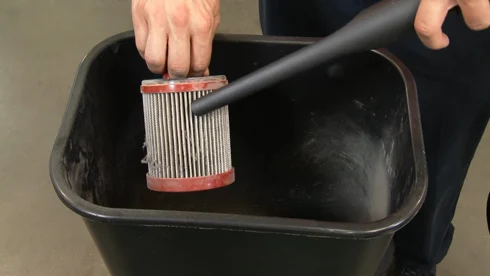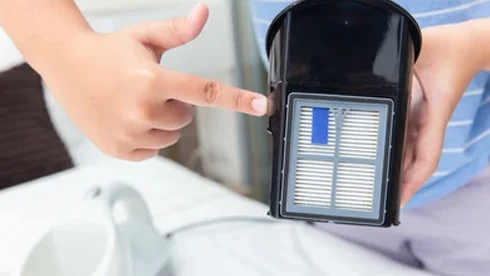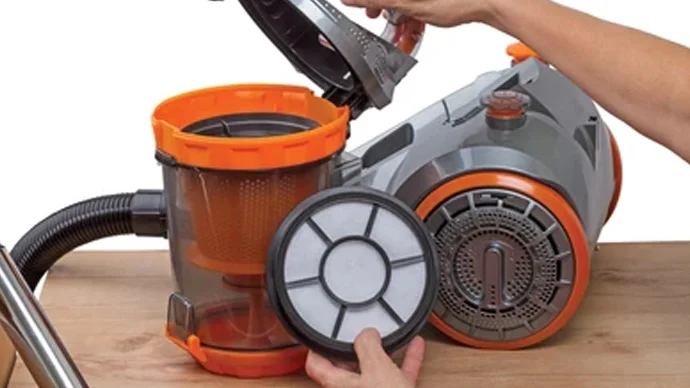Cleaning a vacuum cleaner filter is important because it prevents the machine from becoming clogged with dirt and hair. It is often located near the exhaust port of the vacuum cleaner.
The longer dirt and hair are allowed to accumulate, the less effective your vacuum cleaner will be, even if you clean out the canister or change the bag.
Cleaning vacuum cleaner filters requires a lot of effort if you aren’t familiar with the proper method. You may wonder how to clean a vacuum cleaner filter. Here we will discuss how to clean a reusable filter and other related information. So keep reading and maintain your vacuum cleaner’s efficiency!
How to Identify If Vacuum Cleaner Filter Needs Cleaning?

Not all vacuum cleaners have filters that need to be cleaned. However, if your vacuum cleaner has a filter and it is reusable, it will need to be cleaned periodically to ensure optimal performance.
To determine whether or not your vacuum cleaner filter needs cleaning, look for the following signs:
- The vacuum cleaner is not picking up dirt as well as it used to
- It leaves dirt behind in some areas after vacuuming
- Dirt and hair cover the exhaust port
If your vacuum cleaner exhibits any of these signs, the filter needs to be cleaned.
Different Types of Vacuum Filters:

Different types of vacuum filters require different methods of cleaning. So, the first step is to identify the type of filter your vacuum cleaner has. There are two main types of vacuum filters- reusable and disposable.
Reusable Filters:
Reusable filters are usually made of foam or cloth and can be cleaned with soap and water. These filters should be rinsed thoroughly and allowed to dry completely before being put back into the vacuum cleaner.
Disposable Filters:
Disposable filters are usually made of paper or fiber and need to be replaced when they become dirty. These filters cannot be cleaned and must be thrown away.
What are the Different Types of Reusable Filters?

There are 6 main types of reusable filters- foam, cartridge, HEPA, disk, bag, and activated charcoal.
Foam Filter:
Foam filters are the most common type of filter used in vacuum cleaners. They are made of a porous material that allows air to pass through but traps dirt and dust particles.
These filters can be found in most upright and canister vacuum cleaners. They are usually located near the bottom of the vacuum and front of the main filters where the dirt and dust are collected.
Foam filters should be cleaned regularly to prevent them from becoming clogged and reduce the suction power of your vacuum.
Cartridge Filter:
Cartridge filters are similar to foam filters, but they are made of a harder material that is less likely to become clogged. They are usually found in vacuum cleaners that have a detachable filter cartridge.
These filters are usually used to clean carpets and upholstery. They improve the vacuum cleaner’s ability to pick up pet hair and other large debris.
HEPA Filter:
HEPA filters are the most effective type of filter for trapping small particles such as pollen, dust mites, and smoke. With their special micro-size fibers and electrostatic field, they help to prevent up to 99.97% of dust particles from escaping.
While they are mostly non-washable, they do require special care to clean them. With regular use, HEPA filters can help protect your machine and your lungs from the dangers of micro dust particles.
They are more effective than regular filters and should be used if you have allergies or asthma. They are found in most vacuum cleaners that are marketed as being allergy-friendly.
Disk Filter:
Disk filters are made of pleated paper that traps particles as the air passes through. The disks are held together by a metal frame. They come in a variety of sizes and can be washable or disposable.
These filters are often used in HVAC systems and air purifiers. You’ll find them in a variety of shapes, including circular, oval, and rectangular. The shape of these is similar to a coffee filter.
Bag Filter:
Bag filters are made of a porous material, such as paper or cloth, and are usually filled with filter media such as activated carbon. The media helps to trap dirt and dust particles.
The bag filter design found in canister vacuum cleaners is one of the most common and efficient designs. Thanks to its clever design, the bag filters the dust while also serving as the container. This allows air to pass through while trapping dust particles inside, optimizing the suction power. Plus, when it’s time to empty the dustbin, just take out the bag and throw it away, it’s that easy!
These filters come in a variety of shapes and sizes, but the most common type is the rectangular bag filter. Bag filters are usually found in canister vacuum cleaners.
Activated Charcoal Filter:
Activated charcoal filters are made of a porous material, such as activated carbon, that helps to trap dirt and dust particles. These filters are usually found in air purifiers and HVAC systems.
The activated charcoal layer of filters is great for those who are struggling with keeping the air sanitized and fresh. If you have pets, this product can be a lifesaver. They are also great if you are just generally sensitive to odors. However, in order to maintain their features, they will need regular replacements.
How to Clean a Vacuum Cleaner Filter in a Proper Way?

The way you clean vacuum filter will depend on the type of filter it is. Let’s go over the most common types of vacuum filters and how to clean them:
Steps to Clean a Foam Filter:
If you use a shark vacuum cleaner or other vacs that have a foam filter, you will need to clean it. The steps below will show you how to clean a shark vacuum filter using this method:
Step 1. Remove the foam filter from the vacuum cleaner and place it in a bowl of hot water.
Step 2. Add a mild detergent to the water and stir to create suds.
Step 3. Soak the filter in the suds for about 15 minutes.
Step 4. Rinse the filter under warm water until all the suds are gone.
Step 5. Allow the filter to air dry before reinserting it into the vacuum cleaner.
Steps to Clean to Cartridge Filter:
When your vacuum cleaner has a cartridge filter, it is an easy task to clean it. The filter traps dirt and dust as the air passes through it. If this filter is not cleaned on a regular basis, it will become clogged, and the vacuum cleaner will not work properly.
Step 1. Turn off your vacuum cleaner and unplug it from the wall outlet.
Step 2. Remove the cartridge filter from the vacuum cleaner.
Step 3. Rinse the filter under warm water, using your hand to help loosen any dirt or dust that is clinging to it.
Step 4. Allow the filter to air dry completely before putting it back into the vacuum cleaner.
Steps to Clean a HEPA Filter:
Cleaning a washable HEPA filter on a vacuum cleaner is important for optimal performance. The steps below will show you how to clean a HEPA filter on a vacuum cleaner.
Step 1. Unplug your vacuum.
Step 2. Remove the dust canister or dustbin, if possible.
Step 3. Find your HEPA filter. It’s usually located near the motor of your vacuum.
Step 4. Remove the HEPA filter from its housing.
Step 5. Tap the filter on a hard surface to remove any loose dirt.
Step 6. Rinse the filter with cool water.
Step 7. Allow the filter to air dry completely before putting it back in your vacuum.
Your HEPA filter will be clean and ready to help keep your home clean when you’re finished.
Steps to Clean Disk Filter:
Cleaning the disk filter on your vacuum cleaner is an important part of its regular maintenance. Not only will it keep your vacuum running at peak performance, but it will also help to extend the life of the machine. Here are the steps to clean the disk filter:
Step 1. Unplug your vacuum cleaner and remove the dust bin.
Step 2. Locate the disk filter. It will be either under the dust bin or behind the canister, depending on the model of your vacuum.
Step 3. Remove the filter and rinse it under warm water until the water runs clear.
Step 4. Allow the filter to air dry completely before putting it back in your vacuum.
Step 5. Once the filter is dry, replace it and reassemble your vacuum. Plug it in and turn it on to ensure it is running properly.
Steps to Clean Bag Filter:
If you don’t know how to clean a bag filter on a vacuum cleaner, it’s actually very easy. Just follow these steps, and you’ll have it done in no time.
Step 1. Remove the bag from the vacuum cleaner.
Step 2. Look inside the bag to see if there is any dirt or dust on the filter.
Step 3. If there is dirt or dust on the filter, use a brush or your fingers to remove it.
Step 4. Put the bag back on the vacuum cleaner.
Steps to Clean an Activated Charcoal Filter:
If your vacuum cleaner has an activated charcoal filter, it’s important to clean it on a regular basis. Activated charcoal filters can become clogged with dirt and dust, which reduces their efficiency.
Step 1. Remove the activated charcoal filter from the vacuum cleaner.
Step 2. Rinse the filter with soapy water to remove any loose dirt and dust.
Step 3. If the filter is very dirty, you may need to soak it in a detergent solution for a few minutes.
Step 4. Rinse again the filter with warm soapy water and allow it to air dry completely before replacing it in the vacuum cleaner.
Step 5. Vacuum as usual. Repeat this process every few months to keep the activated charcoal filter clean and effective.
FAQs:
Q: How Often Should You Clean the Vacuum HEPA Filter?

This will vary based on how often you vacuum, how long your hair is or anything else that may get caught up in the filter (kids’ toys and such) and how dirty your home gets. At least, a HEPA filter should be cleaned yearly.
Q: When to Replace a Vacuum Filter?
Replacing a vacuum filter can depend on the type of vacuum cleaner you have, how often it’s used, and the type of filter. The general rule of thumb is to replace a vacuum cleaner filter every 6-12 months.
Q: Can You Clean a Canister Filter?
Yes, you can clean a dirt canister filter. Canister vacuum cleaners have different types of filters, so it is important to know which type of filter your vacuum cleaner has before attempting to clean it. Some filters can be rinsed off under running water, while others may need to be replaced after a certain amount of time.
Q: How do I Know if My EVAP Canister is Clogged?
One way to tell if your EVAP canister is clogged is to listen for a change in the sound of your vacuum cleaner when you’re using it. If the vacuum cleaner sounds louder than normal, the canister may be clogged. You can also check the indicator light on your vacuum cleaner to see if it’s lit up. If it is, the canister is most likely clogged.
Q: How do I Know if My Charcoal Canister is Clogged?
There is a simple way to know if your charcoal canister is clogged. You should be able to hear a loud sucking noise when the engine is running if the charcoal canister is functioning properly. Secondly, you may notice a lot more smoke coming out of one side or both sides of the car.
Q: Do Bagless Vacuums Have Filters?
Yes, a bagless vacuum cleaner has a filter. You need to clean it on a regular basis. The frequency of cleaning will depend on how often you use the vacuum cleaner. It’s important to clean the filter regularly to keep the vacuum cleaner running properly.
Conclusion:
A vacuum cleaner filter is a device that helps to remove dirt, dust, and other allergens from the air that passes through it. If you follow our tips on how to clean a vacuum cleaner filter, you’ll be sure to keep your home free of allergens and your vacuum cleaner running properly.
The most important thing is to check the filter type and manufacturer’s instructions to make sure you’re cleaning or replacing it correctly. There are different types of vacuum cleaner filters, and each type needs to be cleaned or replaced on a regular basis.
We hope you enjoyed this article on cleaning a vacuum filter. If you have any questions or comments, please feel free to leave them below.
